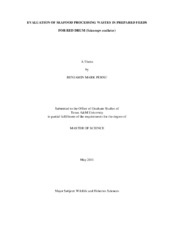| dc.description.abstract | High feed costs and increasing demand for fishmeal have intensified the search for alternative protein sources which are needed to allow world aquaculture to continue expanding. A severely underused marine resource is processing wastes of various types of seafood, which are often disposed of at great cost. Therefore, this study was conducted to evaluate three different types of seafood processing wastes as potential feed ingredients for the red drum (Sciaenops ocellatus).
The three processing wastes evaluated were heads and shells from Penaeid shrimp, and viscera and skeletal remains from filleted black drum (Pogonias cromis) and channel catfish (Ictaluras punctatus). These wastes were blended with soybean meal in a 40:60 ratio, dry extruded and dried to produce stable ingredients. All three byproduct meals produced had crude protein levels ranging from 45 to 50 percent. Two feeding trials were conducted to evaluate the different processing waste byproduct meals in comparison to menhaden fishmeal. A digestibility trial was conducted with sub-adult red drum which led to the computation of apparent digestibility coefficients (ADCs) for organic matter, protein, lipid and energy for each of the byproduct meals. Each byproduct meal had relatively high ADC values that were generally similar to those of menhaden fishmeal.
A comparative growth trial with red drum was then conducted in which experimental diets were formulated with the three byproduct meals replacing menhaden fishmeal on an equal-digestible-protein basis at levels of 65 percent, 80 percent, or 95 percent.
Juvenile red drum were fed the various diets for 8 weeks in a brackish (6 plus/minus 1 ppt) water recirculating system after which weight gain, survival, feed efficiency, as well as whole-body proximate composition and condition indices were measured. All three of the byproduct meals could replace up to 65 percent of the protein provided by fishmeal without adversely affecting performance of red drum. However, the shrimp byproduct consistently provided the highest performance values at 80 percent replacement. The catfish byproduct yielded the lowest fish performance at all levels. This study indicates that dry extrusion of seafood processing wastes can be used to replace a considerable amount of fishmeal in feeds for red drum. | en |


